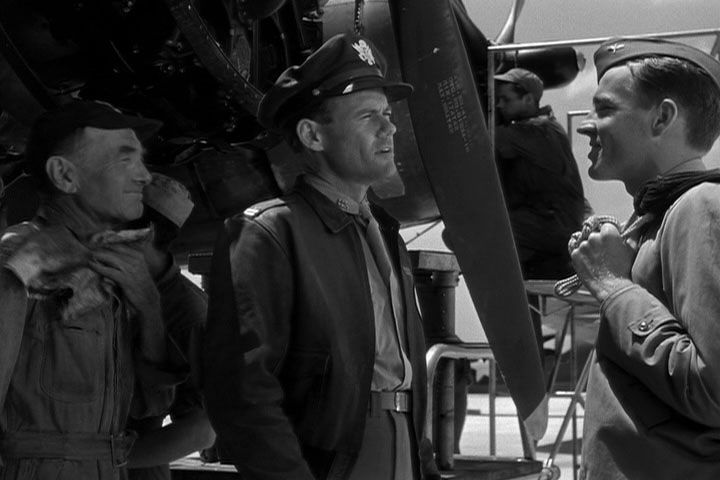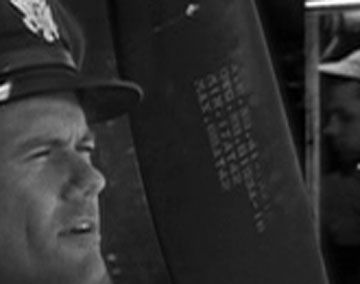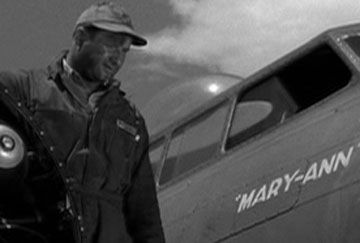I posted this in 2006 on armyairforces.com in 2006:
http://forum.armyairforces.com/B17-Mary-Ann-m96675.aspx
Page 6 / Post # 118
RE: B-17 "Mary Ann" 09/04/2006 07:57:49 AM (permalink)
More on the "Mary Ann."
I have been very busy for the last two months, but I took the time to carefully watch the 1943 Warner Brothers film "Air Force" at least three times in the past several weeks to gather facts on the early model B-17 known as "Mary Ann." From these repeated careful and attentive viewings, I have gathered evidence that indicates that the B-17 known as "Mary Ann" is actually a modified B-17B aircraft rather than a B-17C or later B-17 variant.
When I refer to the B-17 known as "Mary Ann", I am referring to an actual early model B-17 airplane with the name "Mary Ann" painted on it while it is in shot in the motion picture "Air Force." The "Mary Ann" could be more than one airplane as suggested previously by others on this forum. This, from all the material and media I have viewed so far, cannot be determined with any amount of certainty one way or another. For the sake of our discussion, we will assume that the "Mary Ann" is a specific individual B-17.
Throughout this discussion, I will refer to VCR running times as indicated on my newest and highest quality VCR. All movie "times" are approximate since I could not get any of my four VCRs to agree exactly (all of my VCR running times were within several seconds of each other). The VCR time counter was started at 0:00:00 at the Warner Brothers sheild, which is displayed just prior to the opening credits. I also refer to several publications treating B-17 airplanes. Most of these publications can be found at a good public library.
First of all, the most notable differences between a B-17B and a B-17C are the gunner positions. The B-17B has very distinctive "bulging" type gunner blisters in the dorsal (radio room) position, ventral position and waist positions, while the B-17C has "flat" panel waist windows, a conventional "three-pane" radio hatch (discontinued for a short time after the B-17F) and a ventral gunner's tub. These differences can be easily seen in most B-17 reference books. But there are two very subtle differences between the B-17B and B-17C.
The most apparent is the location of the "Commander's Dome" or "Observation Blister", which is located just aft of the flight deck. On the B-17B, the commander's dome is offset to the right on the top of the fuselage aft of the flight deck, while on the B-17C and B-17D this commander's dome has been centered on the fuselage just aft of the flight deck. The centered commander's dome of the B-17C can be seen on the photographs posted by B-24Ken on post # 59. The photo posted by B-24Ken on post # 58 is B-17B 38-211. This B-17B has been modified to B-17C configuration and has often been mistaken for a B-17C in some of the most respected publications, most recently in the August 2006 issue of Flight Journal Magazine. Notice the commander's dome of B-17B # 38-211 (MD 105), it is offset to the right.
In the film "Air Force", the commander's dome of "Mary Ann" can be seen to be offset to the right as with a B-17B airplane. This feature can be seen in the film at running times 0:04:17, 0:05:26, 0:12:29, 0:12:39, 0:57:43, and at 0:59:00. The most obvious shots are at 0:04:17 (Hendricks Field, FL) and at 0:57:43 (the "Wake Island" scene). The commander's dome that is offset to the right (B-17B) and also centered (B-17C) can be seen in the following:
*Air Power Magazine, Vol. 18, No. 2, March 1998, Sentry Books; Page 11.
*B-17 in Detail and Scale (Aero Publishers, Inc.); Page 17, Page 24. On page 17, the photograph is accompanied by the text: "Note the observation blister above the cockpit which is offset to the right. On the B-17C this blister was moved to the centerline."
B-17B airplanes that have been converted to partial or full B-17C configuration can be seen in the following:
*Flying Fortress--The Boeing B-17 (Squadron/Signal); page 12.
*B-17 In Action (Squadron/Signal); page 9.
*Bombers In Action (AF Series Vol. 12, 1993, Challenge Publications); Page 67.
*B-17 In Detail and Scale (Aero Publishers); Page 33.
*Fortress of the Skies (Osprey Publishing); page 6.
*The B-17 Flying Fortress Story (Arms and Amour); page 17.
*Air Force Colors Vol. I 1926-1942 (Squadron/Signal); page 47.
Another subtle difference between B-17B and B-17C airplanes is the shape of the outboard engine carb air scoops. The B-17B has a distinctive "U" or half oval shaped carb scoop while the B-17C has a "V" or teardrop shaped carb air scoop. The U-shape scoop can be seen on the "Mary Ann" in the film at running times 0:11:26, 1:11:06, and at 1:17:31. A B-17 purportedly to be the "Mary Ann" that appeared in the film "Air Force" with a U-shaped carb scoop can be seen in Jeff Ethell's book "Bomber Command" on page 33 and in Warren M. Bodie's book "WWII American War Eagles 1937-1942" on page 155. The U-shape (B-17B) and teardrop shape (B-17C) carb air scoops can be found in many of the works already cited above but especially in the excellent B-17 reference work "B-17 In Detail and Scale" by Alwyn T. Lloyd on pages 18, 20, 22, 23, 24.
In view of the above mentioned evidence, it appears that the early model B-17 known as "Mary Ann" in the film "Air Force" appears to be a B-17B modified to B-17C configuration. As for the suggestion by others that the B-17 "Mary Ann" could be a B-17E or later model configured to resemble a B-17C, it is doubtful and very unlikely from a practical stand point. The entire tail section would have to removed from the later model B-17 and the fuselage and center section mated with an early model B-17 tail. This is very unlikely from a practical view (time and cost) and I'm not sure it is even possible from an engineering stand point (how about it B-17 wrenchers?). Also, the B-17B/C/D model aircraft is about 18 inches shorter in the nose section from the instrument panel forward than a late model B-17E/F/G, making a conversion of this area very difficult and even less likely.
All of this research (and over hundred dollars for Freeman's book and another hundred dollars for AF Aircraft Card microfilm) still has failed to answer the original question I posed at the beginning of this thread: What is the AAF serial number of the early model B-17 known as "Mary Ann" as seen in the 1943 film "Air Force"?
And as for the B-17 known as "Mary Ann" being lost in combat in the Pacific Theater after the film wrapped? Not true in my opinion. Apparently only one B-17B was lost in a warzone and it has been demonstrated by a member in a previous post that it was definitely not the "Mary Ann." I encourage forum members to actually view the film and reference materials and look for the clues I have posited concerning the physical characteristics of the B-17 featured in the film. The airplane appears to be a B-17B, but which one? The answer is out there somewhere. Tony Mireles




